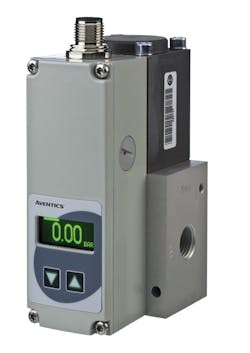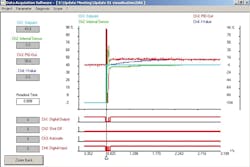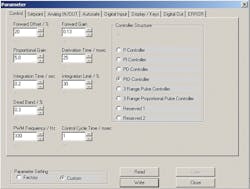How to Choose the Right Proportional Pressure Control Valves
Download this article in PDF format.
Equipment designers find that proportional control technology is ideal where precise performance is required in variable pressure or flow applications. Often perceived as more complicated than other solenoid valves, they provide dependable, cost-effective, compact solutions for fast response and consistent control.
Some typical proportional valve applications include:
- Web/roll tensioning (converting, textiles, paper)
- Laser cutting
- Leak testing
- Fluid spraying or coating (paint, glue, other)
- Medical (air bag, vacuum, other)
- Spot welding
- PET blowing
- Tire balancing and tensioning
- Analytical instrumentation
Application Requirements
When selecting a proportional valve, original equipment manufacturers (OEMs) need to consider what variable needs to be controlled. A pneumatic proportional pressure control valve can not only control pressure, but it can also control other process variables, such as flow, force, rotational speed, position, temperature or level.
After the OEM has established what variables they need to control, they will want to determine other application criteria for their valves, such as:
- Media type, which may influence required valve construction or materials
- Inlet pressure and maximum controlled output pressure
- Required flow range
- Media and ambient temperature
- Other environmental factors, such as hazardous location, vibration, weight or space restrictions
- Power consumption, especially for mobile applications
- Required action on loss of power
The most critical question to ask is whether the application is static or dynamic.
Static vs. Dynamic
Static applications often require that the set point of a desired pressure, controlled via valve opening and closing, remains fixed for the majority of the time. This is the case in leak testing systems where the valve applies a fixed pressure to a component in order to test for soundness. This set point pressure only changes when a different component is to be tested.
Dynamic applications require the set point to change frequently, causing the valve to open and close continually. An example of this situation is in material testing, where the pressure output of the valve is steadily increased until the tested material fails. Other characteristics might be frequently commanded pressure changes with heavy-duty cycling or shifting loads with back pressure that needs continual firing/adjustment. Dynamic applications usually demand a more robust type of proportional valve.
Types of Proportional Valves
There are five basic operating methods used in proportional valve technology.
Piezoelectric valves deform to either open or close the valve when voltage is applied. Piezoelectric operators are incorporated where extremely low power consumption is necessary.
Pneumatic positioners act as pilots to enable air to enter or vent from a diaphragm or cylinder to open or close a much larger valve.
Electrical motor actuated valves use a simple linear actuator to open and close the valve. Designs are based on specific needs of the application and can vary in both dimension and size.
The most popular valves, however, are pulsed air-piloted solenoids and direct-acting proportional solenoids. Because they fall into the middle of the range of capabilities and serve the most applications, it’s helpful to draw some important distinctions between the two.
Pulsed Air-Piloted Solenoids
Pulsed air-piloted solenoids load and unload air pressure in a pilot control chamber which moves a diaphragm and, in turn, acts on a piston to open or close the valve. That can be a slow process that is reliant on pilot valve cycle rates. Through the use of stepped pressure adjustments based on pilot valve cycle times, the result in pressure swings can become too large for some applications where accuracy is critical. These valves also provide minimal adjustment capabilities to optimize their performance.
Air-piloted valves are designed and manufactured incorporating wearable components, such as rolling diaphragms and pulsed solenoid pilot valves that move the piston to regulate pressure. These components add complexity and increase performance variability from valve to valve and can also wear, resulting in degraded performance levels and excess air consumption.
Overall, this means that air-piloted valves are less suited for use with applications that have demanding requirements and/or constantly changing set points—producing heavy solenoid cycling rates that quickly wear out components and they are generally less sensitive to any air quality concerns.
For applications with a static set point, however, they are the best option for cost and power consumption.
Direct-acting Proportional Solenoids
More dynamic applications are better suited when using direct-acting proportional coil solenoid valves, which act directly on pistons or spools to adjust valve open or close positions based on a varying voltage across the coil.
Direct-acting proportional solenoids offer advantages that air-piloted valves don’t. For example, they fit a considerably wider range of applications and provide simpler construction with fewer mechanical parts, simpler principles of operation and more dependable performance capabilities. Direct-acting valves last longer in dynamic operations where valves are cycled more often. Their robust construction reduces the concern about wearable component failure and they are generally less sensitive to any air quality concerns.
Other technical advantages include the ability to reduce overshoot, which is the tendency for a valve to accelerate toward a set point and then go past it, only to have to reverse back toward the set point—possibly overshooting again. This is a common occurrence in systems tuned for short response times. The oscillations typically take less time to settle in direct-acting proportional coil designs because the valve directly moves the piston by varying current to the coil.
Direct-acting proportional coil designs typically provide a finer resolution of pressure control. This can be critical in applications like polishing, which demands small pressure changes to avoid damaging parts. Direct-acting valves precisely vary coil current to make very controlled pressure adjustments.
Overall, the direct-acting design possesses greater speed, responsiveness and resolution that make it superior to air-piloted designs for a number of applications (see table below).
Digital Parameter Tuning
Proportional pressure valves typically offer only a handful of settings for a variety of applications. These settings can be adjusted but often require a time-consuming series of physical adjustments at the factory. Spending lengthy back-and-forth consultations between the customer and the manufacturer to match the valve with the application, or to try to adjust a manual potentiometer in the field, lacks precision. As a result, many OEMs consider direct-acting solenoid valves that feature newer valve technology. This technology offers digital tuning software.
Parameter adjustment software, incorporating a digital oscilloscope, supplies quick and easy adjustments. Advantages include providing high-precision pressure control, streamlining development times, allowing the valve to be adjusted for the application in situ and enabling parameters to be saved and emailed to tech support. For OEMs, this permits presetting valve parameters at the factory, which supplies the best product performance for suitable applications. While dynamic applications are the best candidates for tuning software, applications with ultra-stable pressure control such as leak testing systems can also benefit greatly.
Parameter adjustment software places control in the users’ hands and gives them the ability to change almost any setting, including deadband, analog signal type and shutoff level. Early on during the prototype phase of OEM assembly, design engineers can immediately see the effects of any changes they make.
For example, they can quickly and easily fine-tune the pressure received by a cylinder to obtain a specific force. If necessary, they can make these real-time changes on the phone while receiving expert advice from the manufacturer’s tech support specialists. These features increase speed to market by allowing an OEM to modify the proportional valve as needed during design revisions.
Getting the Right Fit
Analyzing application needs, control concerns and level of digitization are all key in getting to the right decision. Once an OEM is close to making a decision, they will talk with their supplier to determine if they, too, are the right fit.
Proportional Valves With Advanced Capabilities
Currently, the most advanced designs are looking to the Industrial Internet of Things (IIoT) to optimize the performance and service life of a proportional pressure valve. Aventics’ Sentronic valves can be applied to a broad range of specialist machinery applications, while the company’s engineering services can help customize products or manifolds. That ensures proper fit, cost-effectiveness and inclusion of all the features needed for an application.
The Sentronic Series of valves are available in various designs. Both the Sentronic Plus direct-acting and Sentronic LP solenoid air-piloted models are available with IO-Link communication. IO-Link communication supports future implementation of Industry 4.0 and IIoT applications that will contribute toward greater plant reliability, availability and profitability. IO-Link is increasingly being applied to a range of automation applications, providing a cost-effective digital communication interface for sensors, actuators and controllers.
To reduce maintenance time and complexity, the IO-Link module allows the Sentronic valves to identify and configure themselves automatically during component replacement, thereby eliminating the need for configuration via a laptop. The addition of IO-Link technology enables device parameters to be changed directly with the PLC without using data acquisition software.
The entire Sentronic portfolio, however, can be customized for a wide variety of applications using an included data acquisition software that grants access to the PID control loop of the valves. This software includes an oscilloscope feature that charts valve performance PID output and PID variables right in the application—a valuable tool during prototype design. Design engineers can get visual confirmation of pressure control as machine designs are modified. In addition to PID parameters, other variables and features (such as deadband, custom ramps and digital outputs) can all be adjusted as per application needs.
Aventics’ Sentronic series of valves can be configured for double-loop (cascaded) control, which means that multiple feedback components can be incorporated. Each feedback loop would be involved in monitoring a different variable, such as pressure, flow, force, speed or temperature. The only additional component needed would be the sensor that provides the feedback.
Tom Voth is product marketing manager, Pneumatic Machine Safety & Electronic Proportional Valves, Emerson Automation Solutions.






